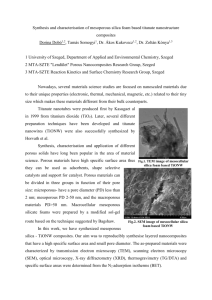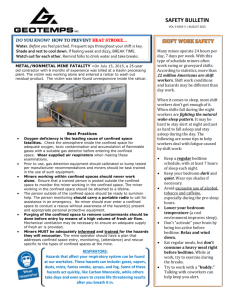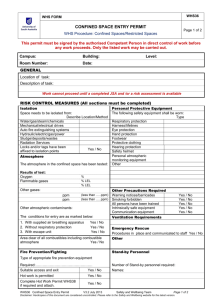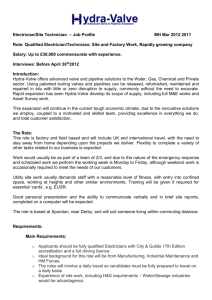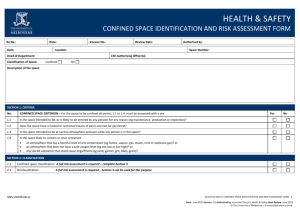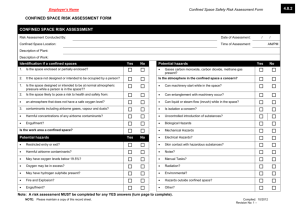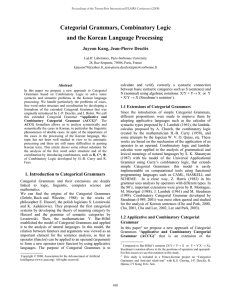P175 - World Journal of Engineering
advertisement
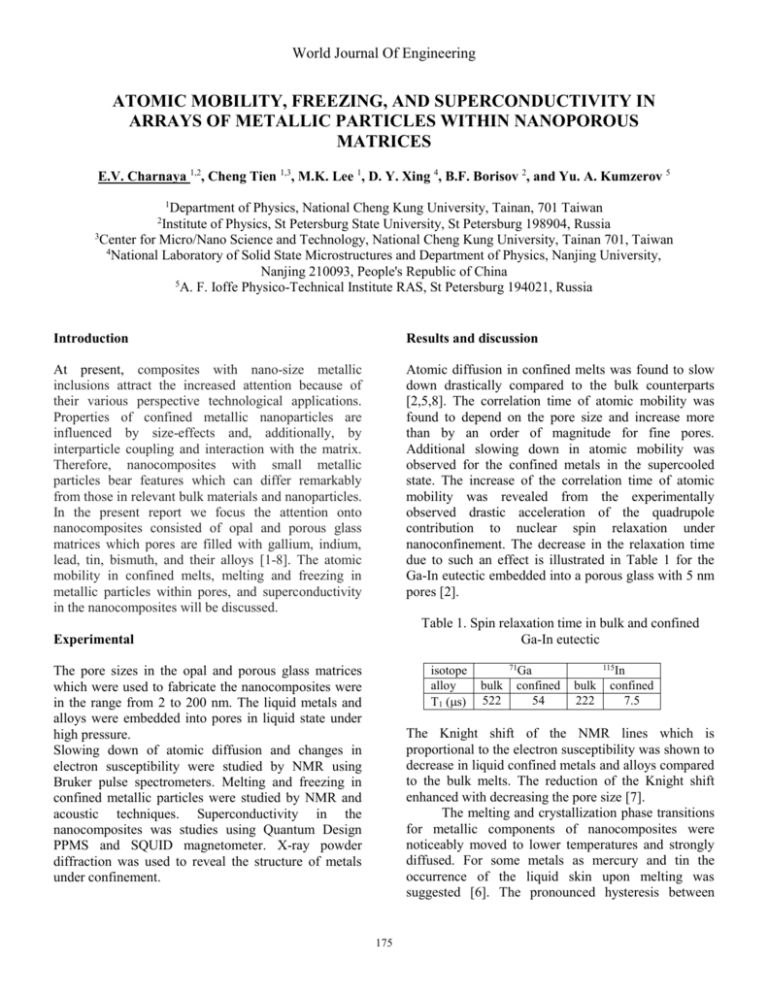
World Journal Of Engineering ATOMIC MOBILITY, FREEZING, AND SUPERCONDUCTIVITY IN ARRAYS OF METALLIC PARTICLES WITHIN NANOPOROUS MATRICES E.V. Charnaya 1,2, Cheng Tien 1,3, M.K. Lee 1, D. Y. Xing 4, B.F. Borisov 2, and Yu. A. Kumzerov 5 1 Department of Physics, National Cheng Kung University, Tainan, 701 Taiwan Institute of Physics, St Petersburg State University, St Petersburg 198904, Russia 3 Center for Micro/Nano Science and Technology, National Cheng Kung University, Tainan 701, Taiwan 4 National Laboratory of Solid State Microstructures and Department of Physics, Nanjing University, Nanjing 210093, People's Republic of China 5 A. F. Ioffe Physico-Technical Institute RAS, St Petersburg 194021, Russia 2 Introduction Results and discussion At present, composites with nano-size metallic inclusions attract the increased attention because of their various perspective technological applications. Properties of confined metallic nanoparticles are influenced by size-effects and, additionally, by interparticle coupling and interaction with the matrix. Therefore, nanocomposites with small metallic particles bear features which can differ remarkably from those in relevant bulk materials and nanoparticles. In the present report we focus the attention onto nanocomposites consisted of opal and porous glass matrices which pores are filled with gallium, indium, lead, tin, bismuth, and their alloys [1-8]. The atomic mobility in confined melts, melting and freezing in metallic particles within pores, and superconductivity in the nanocomposites will be discussed. Atomic diffusion in confined melts was found to slow down drastically compared to the bulk counterparts [2,5,8]. The correlation time of atomic mobility was found to depend on the pore size and increase more than by an order of magnitude for fine pores. Additional slowing down in atomic mobility was observed for the confined metals in the supercooled state. The increase of the correlation time of atomic mobility was revealed from the experimentally observed drastic acceleration of the quadrupole contribution to nuclear spin relaxation under nanoconfinement. The decrease in the relaxation time due to such an effect is illustrated in Table 1 for the Ga-In eutectic embedded into a porous glass with 5 nm pores [2]. Table 1. Spin relaxation time in bulk and confined Ga-In eutectic Experimental The pore sizes in the opal and porous glass matrices which were used to fabricate the nanocomposites were in the range from 2 to 200 nm. The liquid metals and alloys were embedded into pores in liquid state under high pressure. Slowing down of atomic diffusion and changes in electron susceptibility were studied by NMR using Bruker pulse spectrometers. Melting and freezing in confined metallic particles were studied by NMR and acoustic techniques. Superconductivity in the nanocomposites was studies using Quantum Design PPMS and SQUID magnetometer. X-ray powder diffraction was used to reveal the structure of metals under confinement. isotope alloy T1 (s) 71 bulk 522 Ga confined 54 115 bulk 222 In confined 7.5 The Knight shift of the NMR lines which is proportional to the electron susceptibility was shown to decrease in liquid confined metals and alloys compared to the bulk melts. The reduction of the Knight shift enhanced with decreasing the pore size [7]. The melting and crystallization phase transitions for metallic components of nanocomposites were noticeably moved to lower temperatures and strongly diffused. For some metals as mercury and tin the occurrence of the liquid skin upon melting was suggested [6]. The pronounced hysteresis between 175 World Journal Of Engineering M'' (emu/cm3) melting and freezing was ascribed to heterogeneous nucleation under confinement. The step-like freezing and melting of gallium within pores was found to occur due to the emergence of different crystalline phases. The particular phases which can form within pores depended on pore size and geometry. Three new phases were seen for gallium within porous glasses and opal matrices, -Ga, -Ga [3], and -Ga [4]. The melting and crystallization processes within a porous glass with 7 nm pores are shown in Fig.1. Intensity (rel. units) 0.006 2 4 6 8 T (K) Fig.2. Temperature dependences of the imaginary M part of ac magnetization at external static magnetic fields shown on the panel observed for the lead-porous glass nanocomposite. 0.8 -Ga Conclusions 0 1.2 Atomic mobility, electronic properties, melting and freezing phase transitions, structure, and superconductivity were studied in the arrays of metallic and alloy particles embedded into nanoporous silica matrices. The obtained results revealed new features related to size effects and interparticle coupling. 0.8 -Ga 0.4 0 200 240 T (K) 280 Fig.1. Intensity of x-ray peaks for -Ga and -Ga versus temperature for the gallium loaded porous glass with pore size 7 nm. Open and closed symbols correspond to cooling and warming, respectively. References 1. Y.S. Ciou, C. Tien, E.V. Charnaya, D.Y. Xing, Yu.A. Kumzerov, M.K. Lee, and A.L. Pirozerskii. Double peaks on ac magnetization in a superconducting Pb-porous glass nanocomposite. Phys. Lett. A 374 (2010) 4942–4944. 2. E. V. Charnaya, C. Tien, M. K. Lee, and Yu. A. Kumzerov. Atomic mobility in nanostructured liquid Ga-In alloy. J. Phys.: Condens. Matter 22 (2010) 195108. 3. M. K. Lee, C. Tien, E. V. Charnaya, H.-S. Sheu, and Yu. A. Kumzerov. Structural variations in nanosized confined gallium. Phys. Lett. A 374 (2010) 1570–1573. 4. E. V. Charnaya, C. Tien, M. K. Lee, and Yu. A. Kumzerov. Superconductivity and structure of gallium under nanoconfinement. J. Phys.: Condens. Matter 21 (2009) 455304. 5. E. V. Charnaya, C. Tien, M. K. Lee, and Yu. A. Kumzerov. Slowdown of self-diffusion induced by partial freezing in confined liquid indium. Phys. Rev. B 75 (2007) 212202. 6. E. V. Charnaya, C. Tien, M. K. Lee, and Yu. A. Kumzerov. NMR studies of metallic tin confined within porous matrices. Phys. Rev. B 75 (2007) 144101. 7. C. Tien, E. V. Charnaya, M. K. Lee, and Yu. A. Kumzerov. Influence of pore size on the Knight shift in liquid tin and mercury in a confined geometry. J.Phys.: Condens. Matter 19 (2007) 106217. 8. E. V. Charnaya, T. Loeser, D. Michel, C. Tien, D. Yaskov, and Yu. A. Kumzerov. Spin-lattice relaxation enhancement in liquid gallium confined within nanoporous matrices. Phys. Rev. Lett. 88 (2002) 097602. The superconducting transition temperatures for newly observed gallium structures were much higher than that for bulk -Ga. These findings are illustrated in Table 2. Table 2. Temperatures Tc of the superconducting transition in confined gallium crystalline phase Tc (K) 500 Oe 200 Oe 600 Oe 400 Oe 300 Oe 100 Oe 0 1.2 0.4 0.012 -Ga -Ga -Ga 7.1 6.7 6.3 Superconducting features of the nanocomposites were shown to be generally similar to those of dirty type-II superconductors. When the pore filling was high enough, the whole nanocomposites were screened from external magnetic field. A double step transition was observed for nanocomposites when the filling was incomplete. Phase transitions in vortex system were also found. This is illustrated with double peaks in ac magnetization for the Pb loaded porous glass (Fig.2) [1]. For some nanocomposites we also observed magnetic instabilities and fish-tail magnetization loops. 176

